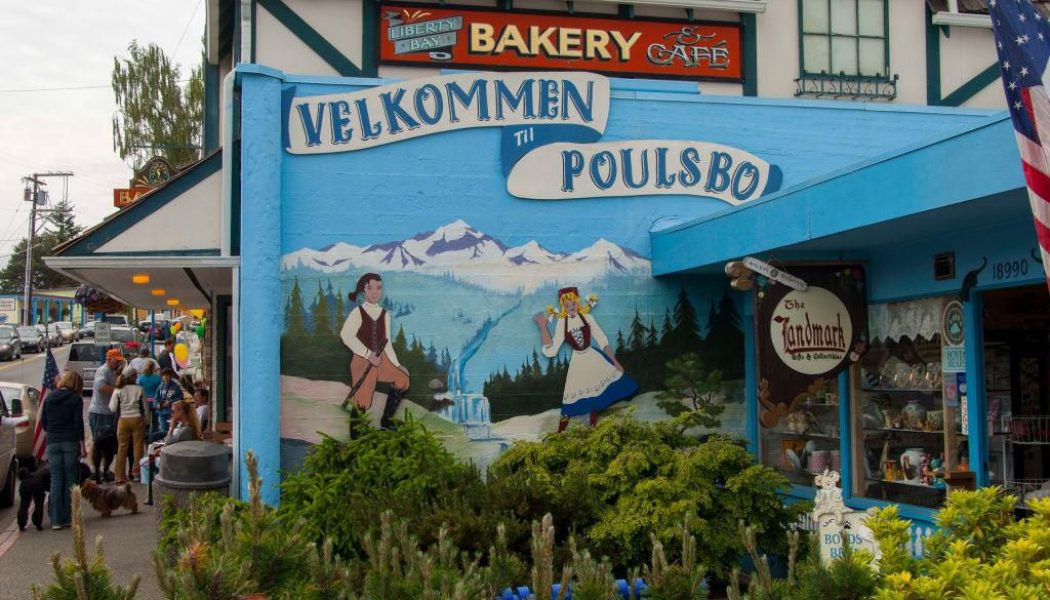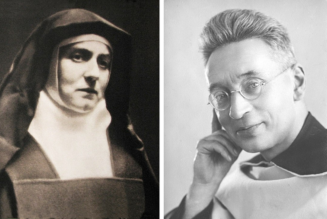With Americans being banned from traveling to Europe due to the high numbers of COVID-19 cases in the United States, many travelers have had to shift their summer vacation plans to locales a bit closer to home. Luckily, you don’t need a passport to experience a taste of European culture right here in the United States. Here are ten towns that will transport you to Europe, minus a flight across the pond.
(Due to COVID-19 closures, we recommend contacting destinations before traveling to ensure that they’re open. Also, please obey local public health precautions, wear a mask, practice social distancing and proper hand hygiene, and travel safely.)
Instead of Norway, visit Poulsbo, Washington

Situated on the Kitsap Peninsula on Puget Sound, Poulsbo (population: 10,927) has come to be known as “Little Norway on the Fjord.” Ever since the earliest settlers immigrated there in the 1880s thanks to the abundance of land available for farming, Poulsbo has been a haven for Norwegians, with residents even retaining their native tongue as the town’s primary language up until World War II. Over the years, Poulsbo has kept a tight relationship with its homeland, and in 1975, Norway’s King Olav V even paid the village a visit. Today Poulsbo remains rich with Norwegian culture, as evidenced by its Scandinavian-style architecture, numerous beer halls and pubs, and annual calendar of events, which includes a Viking Festival in May and Midsommer Festival in June, both geared toward celebrating the town’s heritage through food, music and art.
Instead of Poland, visit New Britain, Connecticut

In the 1930s, one-fourth of New Britain’s population (now 72,495) could claim Polish ancestry. While that proportion has reduced in recent years as more people have flocked there, hints of the city’s Polish beginnings can still be seen around every corner, and especially along Broad Street or “Little Poland.” In this neighborhood, you’ll find Sacred Heart Parish, one of the oldest Polish-American Roman Catholic churches on the East Coast, founded in 1894, alongside restaurants, bakeries, meat markets and pubs advertising everything from kielbasa and pierogi to golabki and paczki. Broad Street also hosts the annual Little Poland Festival (scheduled for 2021) that draws crowds in the thousands looking to experience a slice of Polish heritage through traditional dance, music and food.
Instead of the Netherlands, visit Holland, Michigan

With its boundless fields of blooming tulips and towering windmills, Holland, Michigan—a city (population: 33,327) located 30 miles west of Grand Rapids on the shores of Lake Michigan—is the spitting image of the Dutch countryside. In 1847, the first Dutch settlers arrived there in search of religious freedom, and their historic stamp can be seen throughout Holland. Learn about some of the earliest settlers at the Cappon House (currently open with limited hours), a museum that was once the home of Isaac Cappon, a Dutch immigrant and Holland’s first mayor. Climb four flights of stairs to the lookout deck of De Zwaan, an authentic Dutch windmill built in 1761 in Krommenie, Netherlands, and moved piecemeal by boat to the United States in 1964 where it’s now listed on the National Register of Historic Places. Other points of interest include Nelis’ Dutch Village, a living history attraction set in the early 1900s where you can watch artisans as they carve wooden shoes and learn to klompendansen (clog dance), and a host of eateries like DeBoer’s Bakkerij, a bakery known for its delectable danishes and tijgerbrood, a slightly sweet bread with a crunchy, crackled crust.
Instead of Germany, visit Leavenworth, Washington

Cruising through Leavenworth, Washington, is a lot like driving through one of the many German villages peppering the Bavarian countryside. But unlike its German homeland, this small town (population: 2,010) located 135 miles east of Seattle didn’t always have European leanings. The former logging town received a facelift sometime in the early 1960s under the suggestion of town leaders, who were looking for ways to draw in crowds. They looked to the surrounding mountains for inspiration to create an Alpine-inspired paradise that today comes alive with restaurants and brewhouses, like the Andreas Keller Restaurant, helmed by German-born chef Anita Hamilton, making authentic dishes like würste and schnitzel. The town’s annual Oktoberfest celebration, canceled for this year, typically offers plenty of beer and bratwurst.
Instead of Greece, visit Tarpon Springs, Florida

With one out of every ten of its nearly 25,500 residents claiming Greek ancestry, Tarpon Springs, Florida, has the highest concentration of Greeks living in any city in the United States. The Gulf coast town just outside of Tampa comes alive with Hellenic culture, with the ever-present aromas of Greek cooking wafting from the open windows of its many restaurants and bakeries flanking Dodecanese Boulevard downtown (named after Greece’s Dodecanse Islands). Even today, more than a century after Greek deep-sea divers immigrated there in search of sea sponges, eventually establishing it as “the sponge capital of the world,” Tarpon Springs’ Greek roots hold true, with the city developing sister city relationships in Kaylmnos, Symi, Halki and Larnaca.
Instead of Sweden, visit Lindsborg, Kansas

Called “Little Sweden,” the first Swedish settlers arrived in Lindsborg, Kansas, in 1869, an area that sits smackdab in the center of the state where Interstate 70 and Interstate 135 now intersect. Much of the heritage brought over from the homeland remains intact in the small community of 3,200. At the Birger Sandzén Memorial Gallery on the Bethany College campus, visitors can step back in time by viewing the pastel-toned landscape paintings by artist Birger Sandzén, who arrived in 1894 to teach in the college’s art department. Another glimpse into the town’s Swedish past can be experienced during a stroll through Heritage Square, a downtown grouping of seven historic structures, including a livery stable, wooden windmill and the Swedish Pavilion, which was brought over from Sweden and first displayed in St. Louis during the 1904 World’s Fair.
Instead of Italy, visit Healdsburg, California

With its undulating hills and abundance of vineyards and wineries, the Northern California town of Healdsburg looks strikingly similar to Tuscany. In fact, both locales fall along the same line of latitude and have similar temperate climates, making Healdsburg the ideal growing ground for Tuscan grape varietals like Sangiovese and Cabernet Sauvignon. One winery in particular, Portalupi, specializes in creating Italian-inspired wines, or what the owners (both of whom have Italian ancestry) dub “Cal Ital.” The area is also home to a variety of Italian restaurants specializing in Tuscan cuisine, with menus touting panzanella and ribollita. However, the scenery alone is enough to transport you to a lazy afternoon basking in the Tuscan countryside.
Instead of France, visit Natchitoches, Louisiana

While many people might consider New Orleans as the country’s capital for French culture, 300 miles northwest of the city sits another contender. Founded by French explorer Louis Juchereau de St. Denis in 1714, Natchitoches became the oldest permanent European settlement of the Louisiana Purchase territory. Although Mardi Gras is one of the best times of the year to visit, the town’s French leanings are apparent year-round, from the 33-block Historic Landmark District, which is home of the Basilica of the Immaculate Conception, the area’s first parish church. Just downriver sits the Fort St. Jean Baptiste State Historic Site (open Wednesday through Sunday), a replica of the original settlement, that offers guided tours focused on how the fort once served as a major trading post.
Instead of Spain, visit St. Augustine, Florida

St. Augustine, Florida, boasts a superlative that’s unmatched by all the other cities and towns across the United States that can trace their Spanish roots: It’s the oldest continuously occupied settlement of European origin in the country. Spanish admiral Pedro Menéndez de Avilés reached the shoreline from his homeland in 1565. A number of structures date back to the city’s founding, including Mission Nombre de Dios, a Catholic mission, and the Castillo de San Marcos National Monument (temporarily closed), the oldest masonry fort in the nation. Other notable sites include Colonial Quarter, a living history museum that depicts what life was like in the area during the 1700s, and the Governor’s House Cultural Center and Museum (closed until further notice), which served as the local government’s offices beginning in 1598.
Instead of the Czech Republic, visit West, Texas

Located between Dallas-Fort Worth and Austin sits West (population: 2,982), the “Czech Heritage Capital of Texas” and home of the largest population of Czech immigrants in the state. While many drivers barreling along Interstate 35 may view West as just another blip on the map, in-the-know travelers know it as kolache heaven. Thanks to the town’s numerous bakeries selling these sweet treats—a staple of Czech cuisine comprised of pastry dough stuffed with fruit fillings like cherries or apricots—even the state government designates West as “home of the official kolache of the Texas Legislature.” One of the most popular spots is the Czech Stop and Little Czech Bakery, a combination gas station-bakery-deli-candy shop that is open 24/7. Come Labor Day, the town swells with visitors during Westfest (canceled this year due to COVID-19), a celebration of Czech heritage that dates back to the mid-19th century, when the first immigrants began arriving to the area from Europe in search of new economic opportunities.









